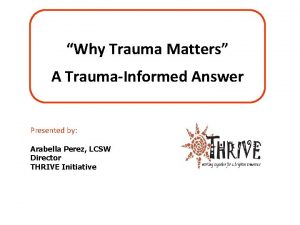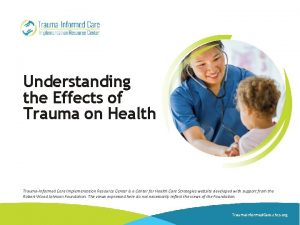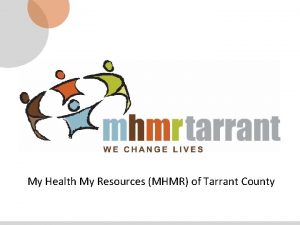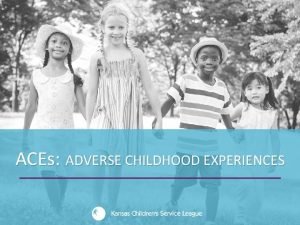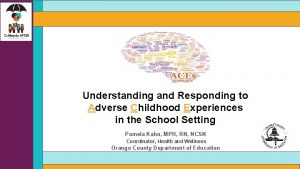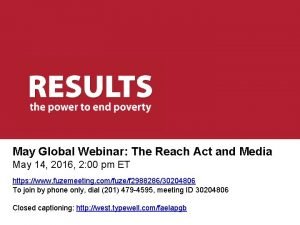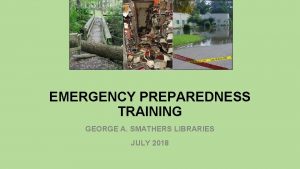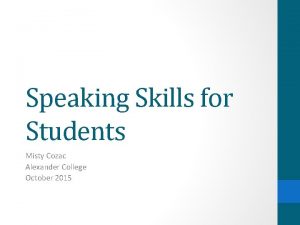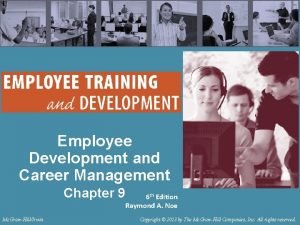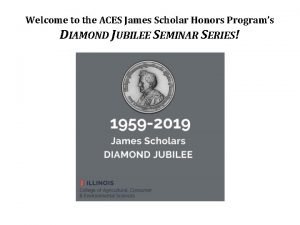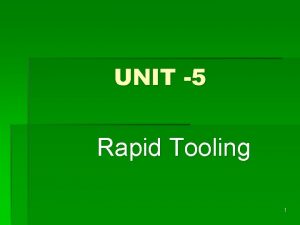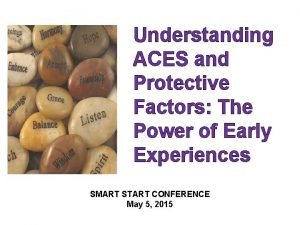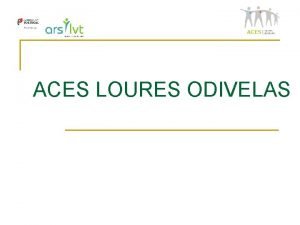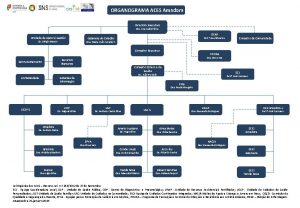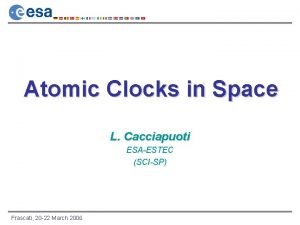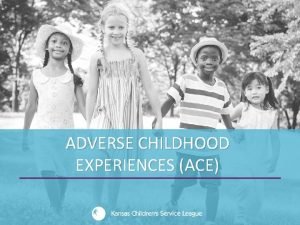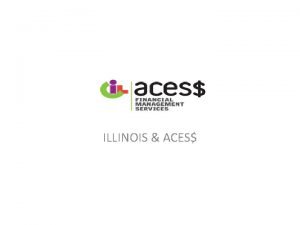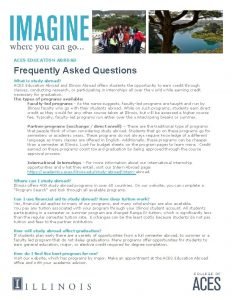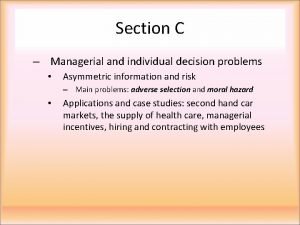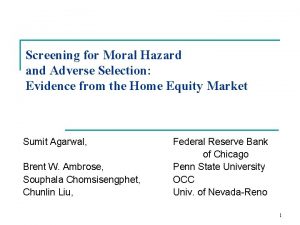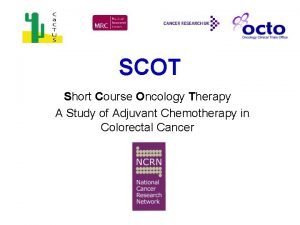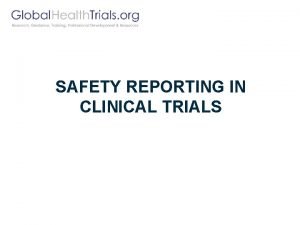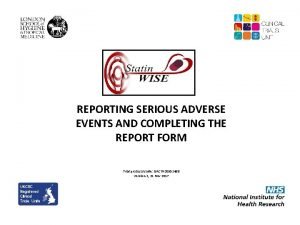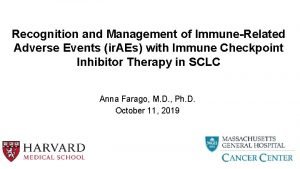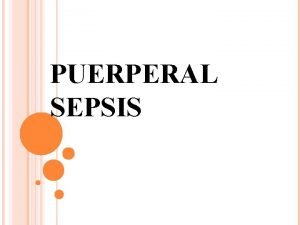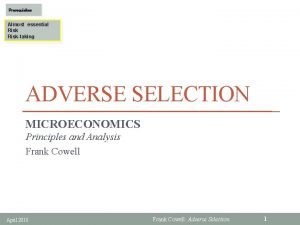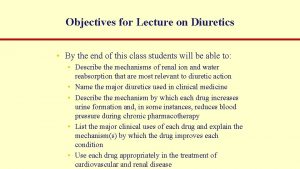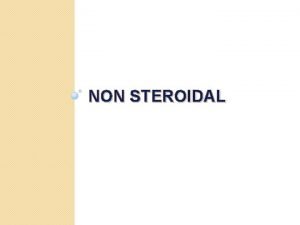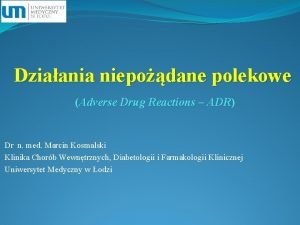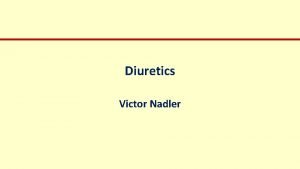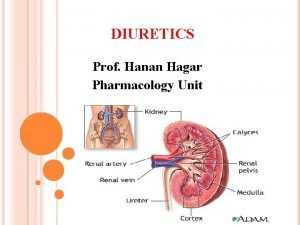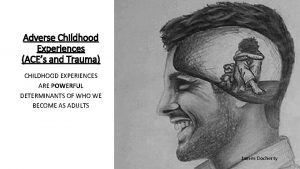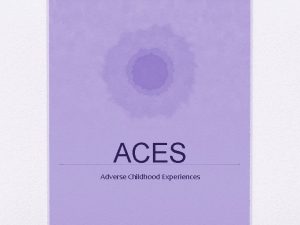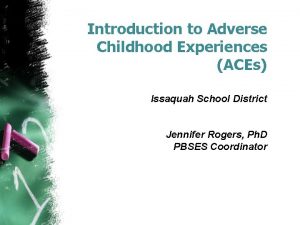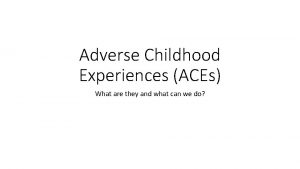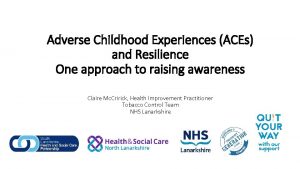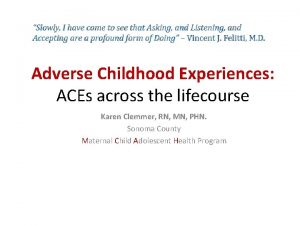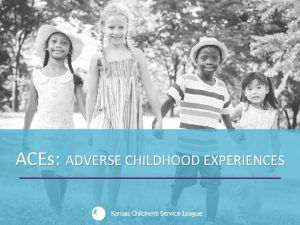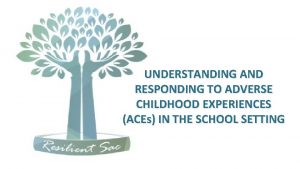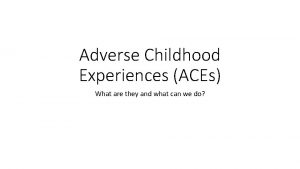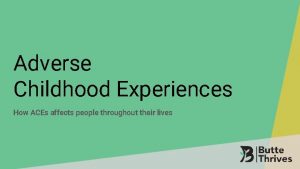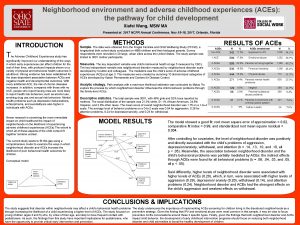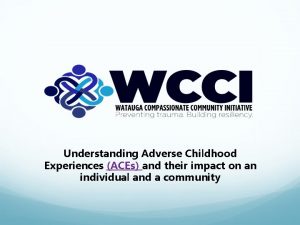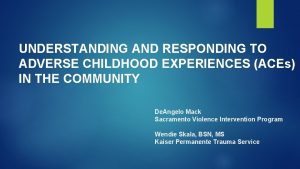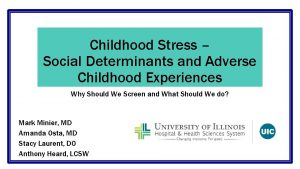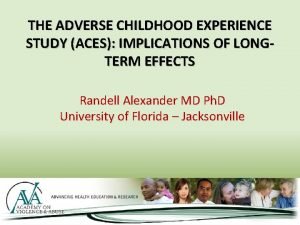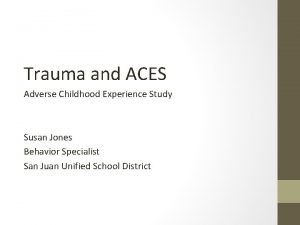Using the Adverse Childhood Experiences Scale ACES Misty














































- Slides: 46

Using the Adverse Childhood Experiences Scale (ACES) Misty Mc. Intyre Goodsell, LCSW Chris Adams Hill, LCSW South Valley Therapy www. southvalleytherapy. com

Objectives • • • Background of ACES Study ACES Questionnaire ACES Outcomes Implementing in practice Macro South Valley Therapy www. southvalleytherapy. com

ACES Background • Collaboration between Kaiser Permanente’s Department of Preventive Medicine in San Diego and the Center for Disease Control and Prevention (CDC) • Dr. Vincent Felitti & Dr. Robert F. Anda South Valley Therapy www. southvalleytherapy. com

ACES Background • 10 year study • 17, 000 participants • Correlated ACES score to health and behaviors occurring over participants’ lifespans • Largest study of its kind South Valley Therapy www. southvalleytherapy. com

Demographics Gender Race Male 46% White 74. 8% Female 54% Hispanic (Latin/Chicano) 11. 2% Asian/Pacific Islander 7. 2% African-American 4. 6% Other 1. 9% Age 19 -29 5. 3% 30 -39 9. 8% 40 -49 18. 6% 50 -59 19. 9% 60 and over 46. 4% South Valley Therapy www. southvalleytherapy. com Education Less than HS 7. 2% High School 17. 6% Some College 35. 9% College Grad or Higher 39. 3%

Questionnaire Additional questions: • Have you ever been a combat soldier? • Have you ever lived in a war zone? • Have you ever been physically abused as a child? • Have you ever been sexually molested as a child or adolescent? • Have you ever been raped? • Who in your family has been murdered? • Who in your family has had a nervous breakdown? • Who in your family has been a suicide? • Who in your family has been an alcoholic or drug user? South Valley Therapy www. southvalleytherapy. com

Outcomes Number of categories (not events) is summed ACE Score 0 1 2 3 4 5 or more Prevalence 33% 25% 10% 6% 11% • 2 out of 3 experienced at least one category of ACE • If any one ACE is present, there is an 87% chance at least one other category of ACE is present, and 50% chance of 3 or more • Women are 50% more likely than men to have a Score of 5< South Valley Therapy www. southvalleytherapy. com

Prevalence of Adverse Childhood Experiences Abuse, by Category Psychological (by parents) Physical (by parents) Sexual (anyone) Neglect, by Category Prevalence (%) 11% 28% 22% Emotional Physical 15% 10% Alcoholism or drug use in home Loss of biological parent <age 18 Depression or mental illness in home Mother treated violently Imprisoned household member 27% 23% 17% 13% 5% Household Dysfunction, by Category South Valley Therapy www. southvalleytherapy. com

Adverse Childhood Experiences Are Common Of the 17, 000 HMO Members: • 1 in 4 exposed to 2 categories of ACES • 1 in 16 was exposed to 4 categories • 22% were sexually abused as children • 66% of the women experienced abuse, violence or family strife in childhood South Valley Therapy www. southvalleytherapy. com

Adverse Childhood Experience Categories Abuse of Child n n n Recurrent Severe Emotional abuse Recurrent Physical abuse Contact Sexual abuse Trauma in Child’s Household Environment n n n Substance abuse Parental separation or divorce Chronically depressed, emotionally disturbed or suicidal household member Mother treated violently Imprisoned household member Loss of parent – (by death, by suicide, - or by abandonment) Neglect of Child n n Abandonment Child’s basic physical and/or emotional needs unmet Impact of Trauma and Health Risk Behaviors to Ease the Pain Neurobiologic Effects of Trauma n n n Disrupted neuro-development Difficulty controlling anger-rage Hallucinations Depression Panic reactions Anxiety Multiple (6+) somatic problems Sleep problems Impaired memory Flashbacks Dissociation Health Risk Behaviors n n n Smoking Severe obesity Physical inactivity Suicide attempts Alcoholism Drug abuse 50+ sex partners Repetition of original trauma Self Injury Eating disorders Perpetrate interpersonal violence Long-Term Consequences of Unaddressed Trauma (ACEs) Disease and Disability n n n n n Ischemic heart disease Cancer Chronic lung disease Chronic emphysema Asthma Liver disease Skeletal fractures Poor self rated health Sexually transmitted disease HIV/AIDS Serious Social Problems n n n n Homelessness Prostitution Delinquency, violence, criminal behavior Inability to sustain employment Re-victimization: rape, DV Compromised ability to parent Intergenerational transmission of abuse Long-term use of health, behavioral health, correctional, and social services

ACEs Background The higher the ACE score, the greater the likelihood of: • Severe and persistent emotional problems • Health risk behaviors • Serious social problems • Adult disease and disability • High health and mental health care costs • Poor life expectancy South Valley Therapy www. southvalleytherapy. com

ACES Background • Big Finding: – Childhood experiences are POWERFUL determinants of adult health outcomes South Valley Therapy www. southvalleytherapy. com

The following information and slides are being used with permission from three sources: 1. September 2003 Presentation of the Child Trauma Treatment Network of the Intermountain West, by Vincent Felitti, MD 2. Powerpoint presentation of Ann Jennings, Ph. D. of The Anna Institute 3. Felitti & Anda (2010). The relationship of adverse childhood experiences to adult medical disease, psychiatric disorders and sexual behavior: implications for healthcare. In Ruth Lanius, Eric Vermetten & Clare Pain (Eds. ), The Impact of Early Life Trauma on Health and Disease: 77 -87. Massachusettes: Cambridge University Press. South Valley Therapy www. southvalleytherapy. com

Emotional Problems South Valley Therapy www. southvalleytherapy. com

Childhood Experiences Underlie Chronic Depression 80 70 % With a Lifetime History of Depression 60 50 Women 40 Men 30 20 10 0 0 South Valley Therapy www. southvalleytherapy. com 2 ACE Score >=4

Childhood Experiences Underlie Suicide South Valley Therapy www. southvalleytherapy. com

Ever Hallucinated* (%) ACE Score and Hallucinations Abused Alcohol or Drugs South Valley Therapy www. southvalleytherapy. com

Percentage With Memory Impairment (%) ACE Score and Impaired Childhood Memory South Valley Therapy www. southvalleytherapy. com

Social Issues South Valley Therapy www. southvalleytherapy. com

ACE vs. Smoking as an Adult 20 18 16 14 12 10 8 6 4 2 0 0 South Valley Therapy www. southvalleytherapy. com 2 ACE Score 4 -5

ACE vs Adult Alcoholism South Valley Therapy www. southvalleytherapy. com

ACE vs IV Drug Use 3. 5 Injected Drugs % Have 3 2. 5 2 1. 5 1 0. 5 0 0 South Valley Therapy www. southvalleytherapy. com ACE Score 3

Childhood Experience Underlie Rape South Valley Therapy www. southvalleytherapy. com

ACE and Likelihood of >50 Sexual Partners South Valley Therapy www. southvalleytherapy. com

Percentage Who Impregnate A Teenage Girl Sexual Abuse of Male Children and Their Likelihood of Impregnating a Teenage Girl 35 30 25 20 15 10 5 0 Not Abused South Valley Therapy www. southvalleytherapy. com 16 -18 Years 11 -15 Years Age When First Abused <=10 Years

Frequency of a girl being physically abused or witnessing one’s mother being abused and the likelihood of ever having a teen Percent who had a teen pregnancy 35 30 Self Motherr 25 20 15 10 5 0 Never Once, Twice Sometimes Often Very

Health Outcomes South Valley Therapy www. southvalleytherapy. com

ACE vs. History of STD South Valley Therapy www. southvalleytherapy. com

ACEs vs. Obesity 12 12 10 9. 5 8 7 6 4 5. 4 2 0 South Valley Therapy www. southvalleytherapy. com 10. 3

Effect of ACEs on Mortality Percent in Age Group 60 19 -34 50 35 -49 40 50 -64 30 >=65 20 10 0 0 South Valley Therapy www. southvalleytherapy. com 2 ACE Score 4

What changes were seen? • 35% reduction in doctor office visits was found in the year following the assessment (compared to the year before) • 11% decrease in ER visits • 3% reduction in hospitalizations • These changes returned to baseline after two years when medial staff returned to previous medical model without asking about ACEs or including treatment for the identified trauma Felitti & Anda, 2010 South Valley Therapy www. southvalleytherapy. com

Power of the ACE Study • • • Simplicity The Data Tell A Simple Story ACEs are common ACEs are highly interrelated ACEs pile up and have a cumulative impact ACEs account for a large percentage of health and social problems Biologic Plausability South Valley Therapy www. southvalleytherapy. com

What presents as the PROBLEM may in fact be an attempted solution South Valley Therapy www. southvalleytherapy. com

Assessment • ACES is an assessment tool – 24 Hour Hotline • Your ACE score never changes • How do we track progress? – BDI, BAI, OQ, YOQ, Suicide Assessments, PCL-C – Resiliency: Empowerment Scale, Youth Self. Efficacy Scale South Valley Therapy www. southvalleytherapy. com

Approach • Use a Trauma Lens – Shifting from What is wrong with this person? to What has this person been through? • Routinely seek a history of adverse childhood experiences from ALL patients • Acknowledge their reality by asking, “How has this affected you later in life? ” • Transparency South Valley Therapy www. southvalleytherapy. com

Intergenerational Impact • Children of Parents with ACE scores are secondary victims – Historical Trauma • Parents with ACE scores will often lack coping and resilience that fosters effective parenting – What does this mean for the extended family of our adult patients? South Valley Therapy www. southvalleytherapy. com

Therapy • There is no SINGLE recommended approach • Trauma Based Therapies: – Trauma Based CBT – EMDR – DBT – EFT (Tapping) – Mindfulness CBT (MCBT) • Family Therapy South Valley Therapy www. southvalleytherapy. com

Therapy • Depression • Psycho-Education – i. e. DBT Skills, Communication, Stress Management • Whole-Person Approach • Referrals South Valley Therapy www. southvalleytherapy. com

Strength Building South Valley Therapy www. southvalleytherapy. com

Micro Recommendations • Implementation – Private Practice – Health Facilities – Senior Living – Corrections – Education System • Make Personal Connections to MDs and Nurses • Connect Children to Resiliency Activities • Mind-Body Connections South Valley Therapy www. southvalleytherapy. com

Macro Recommendations • ACEs becoming a primary assessment tool in mental and physical health agencies and organization • Encourage clinical research on trauma and its treatment • Providing funding to treat trauma should become a priority for Insurance, business, government etc. – Good for individuals, families and communities – High Economic Impact Whitfield, 1998 South Valley Therapy www. southvalleytherapy. com

Macro Recommendations • Effective parenting programs – Parenting education starting as part of K-12 Education • Recognition of ACES/trauma and appropriate treatment should be a mandatory component of education for all health professionals • Create and Endorse Primary Prevention Efforts South Valley Therapy www. southvalleytherapy. com Whitfield, 1998

Considerations • Baby Boomers and Older Persons are a population that didn’t access or talk about mental health (cultural norm) South Valley Therapy www. southvalleytherapy. com

Local Resources • Trauma Informed Care Network – www. ticn. org • Rape Recovery Center • UCASA – 40 Hour Training • Utah Domestic Violence Council – uuadvt. org • Utah Department of Health – BRFSS Study South Valley Therapy www. southvalleytherapy. com

National Resources • ACEs Connection – Online Community of Researchers, Clinicians and Policy Makers • The Anna Institute – www. theannainstitute. org • ACE Response – www. aceresponse. org South Valley Therapy www. southvalleytherapy. com

References Anda RF, Butchart A, Felitti VJ, Brown DW. (2010). Building a Framework for Global Surveillance of the Public Health: Implications of Adverse Childhood Experiences. Preventive Medicine, 39 (1): 93 -98. Felitti & Anda (2010). The relationship of adverse childhood experiences to adult medical disease, psychiatric disorders and sexual behavior: implications for healthcare. In Ruth Lanius, Eric Vermetten & Clare Pain (Eds. ), The Impact of Early Life Trauma on Health and Disease: 77 -87. Massachusettes: Cambridge University Press. Whitfield CL. (1998). Adverse Childhood Experiences and Trauma (editorial). American Journal of Preventive Medicine, 14: 361– 363. South Valley Therapy www. southvalleytherapy. com
 Adverse childhood experiences study
Adverse childhood experiences study Adverse childhood experiences study
Adverse childhood experiences study Adverse childhood experiences study
Adverse childhood experiences study Schoolsworkpro
Schoolsworkpro What are adverse childhood experiences
What are adverse childhood experiences Misty novitch
Misty novitch Misty swain
Misty swain There once was a unicorn
There once was a unicorn Misty cozac
Misty cozac Misty douglas
Misty douglas Misty parks
Misty parks Middle childhood age
Middle childhood age Using job experiences for development assumes that
Using job experiences for development assumes that Aces james scholar
Aces james scholar Ace writing examples
Ace writing examples To be recognized as an “ace of aces” a cadet must
To be recognized as an “ace of aces” a cadet must Aces paragraph structure
Aces paragraph structure Kirksite tooling
Kirksite tooling Aces protective factors
Aces protective factors How to write an aces paragraph
How to write an aces paragraph Answer
Answer Centro saude urmeira
Centro saude urmeira Aces amadora
Aces amadora Aces check cashing
Aces check cashing Aces
Aces Aces
Aces Schoolsworkpro
Schoolsworkpro Aces$ online
Aces$ online Aces study abroad
Aces study abroad Adverse reaction definition
Adverse reaction definition Sentinel event بالعربي
Sentinel event بالعربي Adverse selection
Adverse selection Adverse selection
Adverse selection Adverse reaction definition
Adverse reaction definition Adverse reaction definition
Adverse reaction definition Adverse events in hospital
Adverse events in hospital Ir adverse event
Ir adverse event Puerperal sepsis definition
Puerperal sepsis definition What is adverse selection
What is adverse selection Effects of paracetamol
Effects of paracetamol Loop diuretics adverse effects
Loop diuretics adverse effects Analgesic mechanism
Analgesic mechanism Dpp-4 inhibitors side effects
Dpp-4 inhibitors side effects Adverse selection
Adverse selection Azalastyna
Azalastyna Harley nadler
Harley nadler Diuretic classification
Diuretic classification
